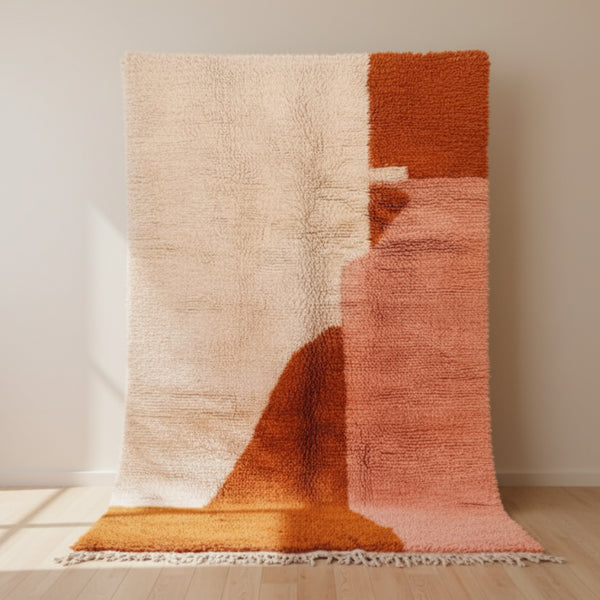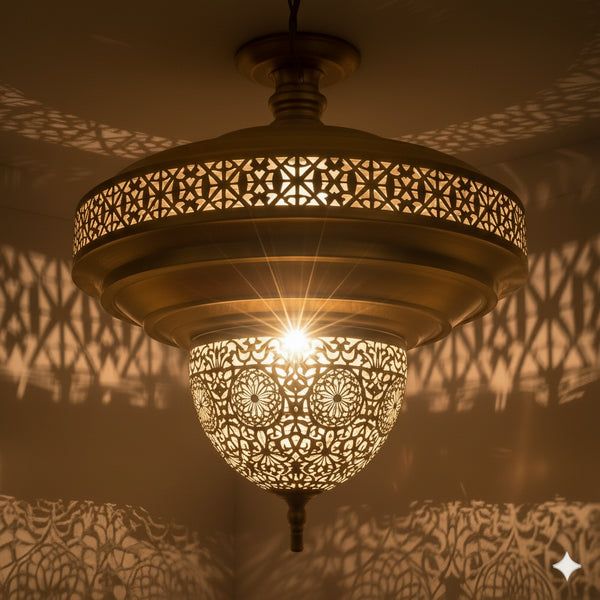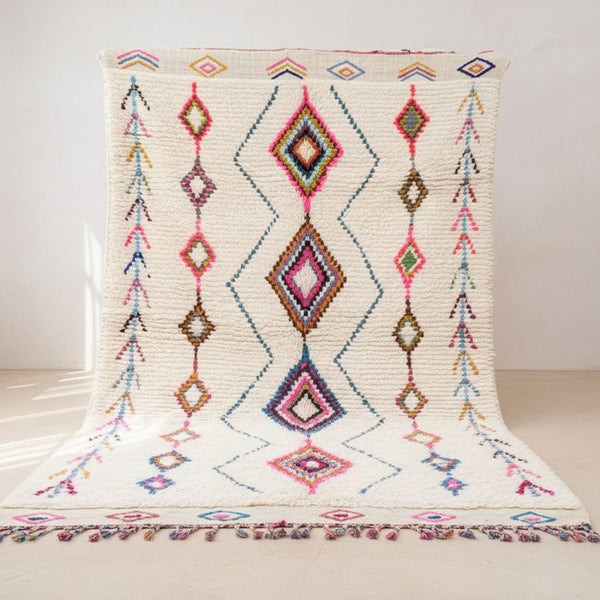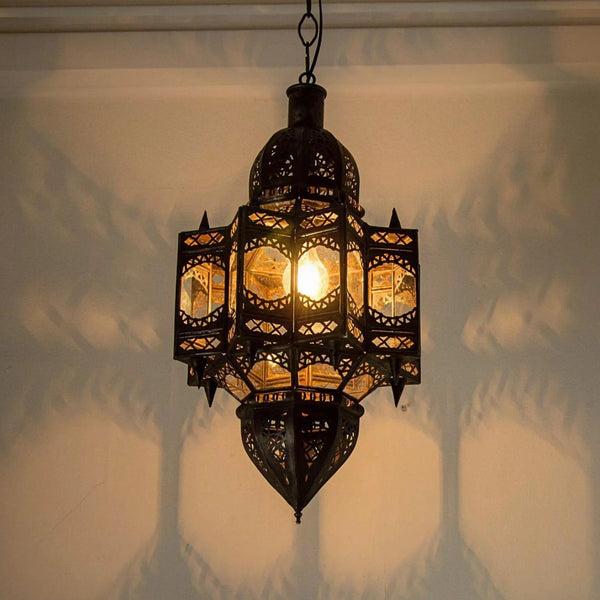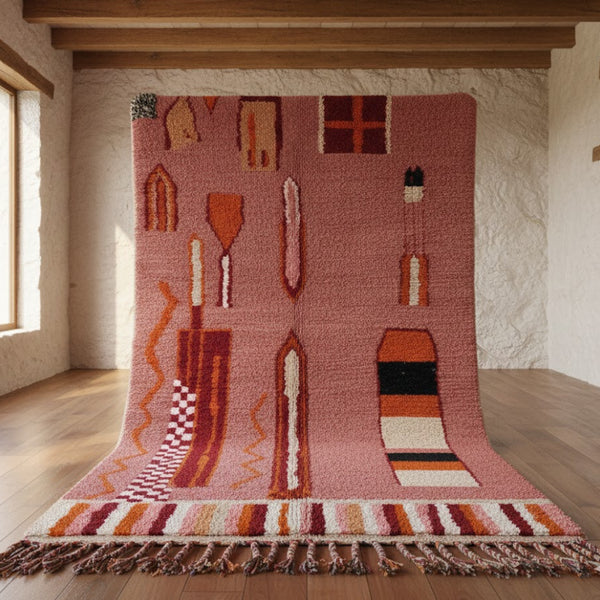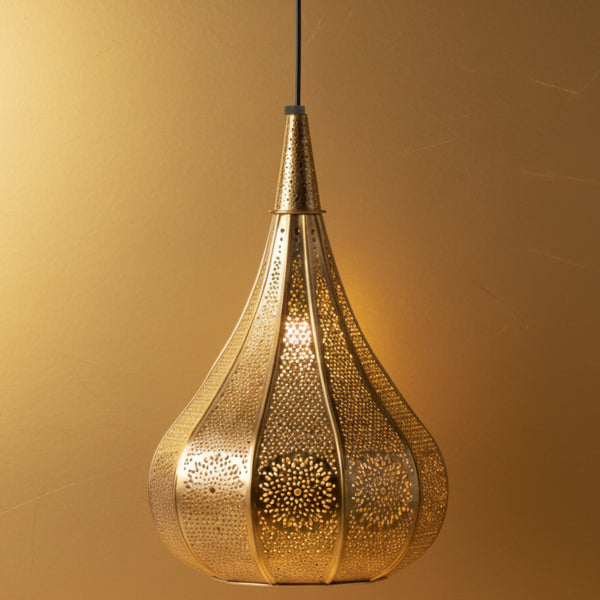Pairing Bohemian Rugs with Brass Lighting – A Style Guide
Posted by AADIL KHAN
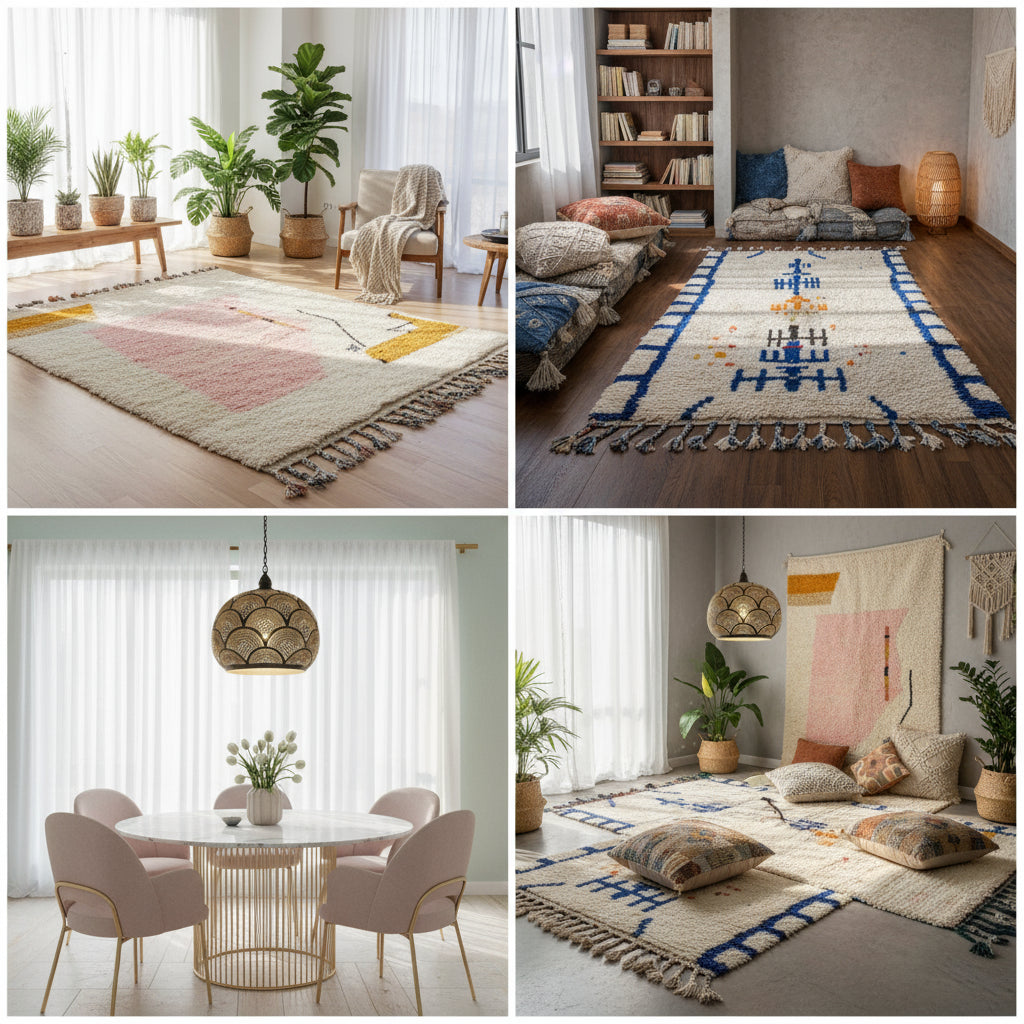
When the warm glow of brass metalwork dances across the intricate patterns of a handwoven rug, it creates a symphony of texture, light, and cultural richness that defines exceptional bohemian interiors. This pairing is more than just coordination; it is the philosophical heart of boho design, where global artisan traditions meet personal expression and where every piece tells a story of craftsmanship and collection. These pieces go well together because they are all handmade and show signs of human creativity. Their warm color palettes seem to go together perfectly, and they can turn ordinary rooms into layered sanctuaries full of personality. This complete style guide shows you the design rules, color schemes, and useful tips you need to master this interesting combination, making spaces that feel both professionally curated and very personal.
Learning about the Bohemian Aesthetic Foundation
Real bohemian style doesn't have a strict definition. Instead, it celebrates a way of thinking that values creative freedom, cultural appreciation, and the joy of being around things that mean more to you than just decoration. The bohemian style is all about layering—of fabrics, light sources, and meaningful objects. This makes the look rich and rewarding to look at for a long time, as it shows new details over time. This method is the opposite of minimalist restraint; instead, it finds beauty in abundance when it is carefully put together.
Bohemian design is influenced by cultures from all over the world, so it is important to use cultural elements from different traditions in a respectful way. This is especially true for textiles and metalwork from places with rich histories of craftsmanship. This isn't about stealing, it's about appreciating and buying real pieces that honor their origins while helping traditional craftsmanship stay alive. Putting a vintage Turkish kilim next to a Moroccan brass lantern makes two different artistic styles talk to each other because they are both handmade.
Handmade items are what make real bohemian spaces stand out from commercialized boho-chic copies. The slight imperfections in hand-knotted rugs, the differences in hand-pierced metalwork, and the organic patina that develops on brass fixtures all show that they are real and add a human touch that makes spaces feel more alive than sterile. Mass-produced copies that try to look like bohemian styles always fail because they don't have this proof of individual artisan hands.
It takes time and effort to create the kind of bohemian interiors that are so appealing. You can't just do it in one shopping trip. Each piece should feel like it was chosen, not matched, and together they should tell a story of travels, discoveries, and personal connections. This philosophy frees you from the need to match things up, but it also makes you think more carefully about how to make sure that different parts come together in a way that is harmonious.
What Vintage Kilim Rugs Do in Bohemian Spaces

Bohemian interiors need vintage kilim rugs because they are so versatile, visually striking, and true to their culture that few other textiles can match them. These flatweave pieces, which nomadic tribes in Turkey, Persia, and Central Asia used to make, have bold geometric patterns in bright colors that give them a bohemian feel right away. Kilims are better for layering, hanging on walls, or draping over furniture because they are lighter and have designs that can be flipped over. This is the kind of flexible use that bohemian style loves.
The traditional patterns on real vintage kilim rugs have meanings that come from the culture that made them. These meanings range from symbols of fertility to protective motifs that have been passed down through generations of weavers. Knowing these cultural backgrounds will help you make better design choices and show off and honor these textile treasures. Diamond patterns, stepped designs, and stylized floral motifs all tell different stories. They turn your floor covering into a cultural narrative that adds more than just decoration to your space.
Turkish vintage kilim rugs have bright jewel tones, while Afghan vintage kilim rugs have more muted earth tones. The natural dye variations give these textiles their beautiful color complexity. The faded look of real vintage items adds a touch of sophistication that lets them work even in rooms with a lot of different patterns. When you put vintage kilim rugs with brass lighting, the soft color intensity makes the metalwork's golden glow stand out without competing for attention.
Vintage kilim rugs are especially valuable in bohemian designs where several textiles are used to create the desired richness. A kilim can be used as the base layer under a smaller pile rug. This adds depth to the patterns and lets both pieces shine. Kilims also make great runners in hallways or other long, flat areas where their flatweave construction and durability are useful in addition to their beauty.
Adding a handmade Moroccan wool rug for texture and warmth

A vintage kilim rug adds pattern and flatweave interest, but a handmade Moroccan wool rug adds the soft comfort and strong presence that make bohemian spaces feel like home. These pile rugs, especially ones like Beni Ourain with their thick, high-pile construction, feel luxurious underfoot and provide a neutral or subtly patterned base that balances brighter accent pieces. The depth of the texture in good wool pile gives furniture groups a sense of weight and defines conversation areas in larger open-plan spaces.
When choosing a handmade Moroccan wool rug, you should think about the patterns based on how you plan to layer them and how complicated your brass lighting choices are. Minimalist Beni Ourain pieces with simple geometric patterns on cream backgrounds are great for showing off fancy brass fixtures because they let the light shine through. On the other hand, colorful abstract designs on richly patterned Azilal or Boujaad wool rugs can make a bold statement, while simpler brass shapes can give the eye a break.
To size a rug correctly, you need to know if it will be used as a base layer or an accent layer. Your handmade Moroccan wool rug should be big enough to fit at least the front legs of all the main seating pieces in your living room. This will make the rug feel like it's been carefully arranged into zones. This generous size gives you the solid base that bohemian layering needs, making sure your space feels full instead of empty. In bedrooms next to beds or in reading nooks, smaller wool rugs make better accent pieces because their soft comfort makes certain areas more comfortable.
These wool pile rugs are warm in two ways: they keep heat in and they look warm because of the natural fiber tones. This makes the perfect base for bohemian comfort. The light from the brass lighting makes the textured wool surface look like it has honey on it. The shadows and light that play across the pile variations make the room look interesting in a way that changes throughout the day. The way the precise holes in metalwork and the organic texture of textiles work together is a perfect example of the material contrasts that make bohemian pairings so interesting.
Choosing brass Moroccan lamps that go well with the patterns in your textiles

To choose brass Moroccan lamps that go well with your textiles, you need to know how metalwork patterns and woven designs work together so that they talk to each other instead of competing with each other. If your rugs have bold geometric patterns, you might want to use brass fixtures that have more natural, flowing shapes in their silhouettes, even if their perforation patterns are still geometric. This shape contrast makes the picture more interesting while keeping the geometric language consistent. On the other hand, if you're using more abstract or flowing textile patterns, crisp geometric brass shapes give the structure that keeps things from looking chaotic.
When balancing pattern intensity across textiles and lighting, scale becomes very important. A general rule says that rugs with a lot of patterns and busy designs go best with brass fixtures that have simpler shapes overall, even if their perforated details are still very detailed. The important thing is to make sure that one part gives your eyes a break. For example, if your handmade Moroccan wool rug has complicated tribal patterns covering most of its surface, choose brass lamps with big, solid areas that balance out the holes. This stops the overwhelming feeling that happens when every surface needs the same amount of attention.
The finish choices in brass have a big effect on how well fixtures match textile colors and the overall style of the room. Antiqued or aged brass with a developed patina goes perfectly with vintage kilim rugs, giving your space a unified vintage look. The soft golden tones of aged brass go well with the faded colors of real vintage textiles without being too bright. Polished brass, on the other hand, adds a modern touch that goes well with newer, brighter fabrics. This creates a deliberate contrast between old and new that is characteristic of eclectic bohemian style.
To make the floor textiles and overhead lighting talk to each other visually, you can use the same colors, shapes, or patterns in both places. Brass fixtures with amber or blue glass inserts make direct color connections with rugs that have terracotta and indigo tones. Geometric patterns in fabrics can be seen in the holes that are cut into metalwork. These small repetitions create a sense of cohesion in the mind that makes spaces feel like they were planned out instead of just thrown together.
Using Moroccan pendant lights to create a bohemian look
Moroccan pendant lights are great for creating the layered, cozy lighting that makes a real bohemian atmosphere. They go beyond just hanging one light from the ceiling and instead use clusters of lights to add visual interest and functional flexibility. Putting up several pendants at different heights over dining tables adds visual interest and allows you to change the amount of light for different occasions. This vertical layering is like the horizontal textile layering on your floors, making the design language in the room consistent.
In bohemian settings, clustered arrangements look especially good. For example, three to five coordinating pendants hung at different heights above coffee tables or reading nooks make sculptural lighting installations that draw the eye. To get the bohemian look that celebrates things that have been collected over time, mix sizes in these groups. For example, have a bigger central pendant with smaller ones on either side. The different heights make sure that light reaches all levels, getting rid of dark spots and making the soft, ambient light that is perfect for relaxed bohemian living.
Moroccan pendant lights change the mood of meals by casting shadows on nearby walls and ceilings while shining directly on the table. The holes in the brass make light projections that change all the time, which makes gatherings more fun. The warm metallic glow also makes food look better. The combination of richly patterned rugs on the floor and ceiling creates an immersive sensory experience that involves both planes.
Single-statement Moroccan pendant lights are great for reading nooks and cozy corners because they give focused task lighting while still looking nice. You can use more elaborate or colorful fixtures in these smaller spaces without them being too much for bigger ones. This will make your home feel like a jewel box. The filtered light that comes through the perforated brass is bright enough to read by without being too harsh, which is exactly what bohemian spaces want to feel like.
Color Coordination: How to Match Brass Tones with Rug Colors
Knowing how the color temperature of brass finishes and textile palettes work together makes sure that the pairings look like they were meant to be together instead of just happening by chance. Rugs with warm colors like terracotta, rust, saffron, and burnt orange go well with old brass that has similar golden undertones. This similar color relationship makes a calming harmony where things seem to go together and work well together. The slightly tarnished quality of old brass keeps the pairing from looking too matchy-matchy while still showing clear color kinship.
Deep blues, emerald greens, and rich purples in jewel tones look great next to polished brass. The warm metal really stands out against the cool colors of the rugs. This complementary relationship gives spaces energy and visual interest, which keeps them from getting sleepy when everything is at the same temperature. The brass adds warmth to mostly cool color schemes and balances the palette. Its shiny surface looks great against matte fabric textures.
If you want your brass fixtures to be the main design statements in your room, use neutral rugs in cream, beige, gray, or natural undyed wool. These colors will go with anything. This method works especially well when you want dramatic, ornate Moroccan pendant lights to be the jewelry of the room, with simple textile bases that let the metalwork shine. The neutral background also gives the eyes a break, which is important in rooms with a lot of patterns and decorative items.
When working with supposedly neutral fabrics or old brass finishes, it's important to know about undertones. Cream rugs with warm yellow undertones go well with any brass finish, while those with cool gray undertones look best with cooler-toned aged brass or a mix of metals. Brass patina can also be more greenish or more golden, which changes the colors of textiles that go best with it.
How to Layer for a Professional Look
Getting the hang of rug-on-rug layering gives your professionally styled bohemian space the depth that sets it apart from amateur attempts. Start with your biggest, most neutral piece as the base. This is usually a handmade Moroccan wool rug or sisal. Then, add a smaller, more visually interesting piece on top. On all sides, the bottom rug should go past the top layer. This will make a border that frames and lifts the accent rug. This method lets you use more than one favorite fabric while still keeping the floor plan useful.
To mix patterns well, you need to know how to use scale and visual weight to your advantage. Instead of having patterns of the same size that compete with each other, use patterns of different sizes that go well together. A vintage kilim with a bold pattern can go over a base with a subtle texture, or a Moroccan wool rug with a lot of patterns can hold down a simpler kilim overlay. The secret is to make sure that one pattern stands out while others add interest without competing with it.
When you mix busy fabrics with simpler lighting (or the other way around), you avoid the visual chaos that is too much to handle. When your textile layers have the most complicated patterns, pick brass fixtures with cleaner lines and less complicated holes. Let one category, like textiles or lighting, add pattern richness while the other gives the eye a break with simpler shapes or bigger solid areas.
Using color and motif repetition to create visual flow connects things that don't seem to go together into a whole. Take one accent color from your layered rugs and use it again in colored glass in your brass fixtures. Echo the geometric shapes in your metalwork by using the holes in your textile patterns. These small links create a sense of harmony in the mind that makes random combinations feel planned instead of random.
Guide to Using in Each Room
Living rooms look better with lots of rugs layered on top of each other to hold seating groups in place, and with brass lights at different heights to add depth and atmosphere. Place your biggest handmade Moroccan wool rug so that it fits all of your seating, put a vintage kilim on top of the coffee table, and hang clustered Moroccan pendant lights off-center to make the room look more interesting. To get the layered lighting that is so important for bohemian comfort, put brass floor lamps in reading corners and table lamps on consoles.
In bedrooms, there should be soft, plush rugs made of wool next to the bed or under the bed frames that go all the way to the footboard. Put matching Moroccan pendant lights on either side of the bed as bedside lamps. They should hang low enough to read by and make cozy lighting areas. For more pattern and the bohemian look that collected bedrooms go for, put a small vintage kilim on top of the bigger wool rug at the foot of the bed.
Dining rooms show off this combination at its best, with large, richly patterned rugs under the tables and bold brass pendants hanging 30 to 36 inches above the table. The rug should go at least 24 inches past the edge of the table so that chairs can be pulled out. Choose pendants that cast a lot of light down to brighten up meals while their shadow patterns keep you entertained and the warm brass glow sets the mood for gathering.
Entryways are a great place to make a big impression right away. Pair runner-style vintage kilim rugs with big brass pendant lights to give your home a bohemian look right away. The narrow runner shape is great for hallways and entries because it adds the right amount of color and pattern. Overhead brass lights draw the eye up, making ceilings that are the right height feel bigger and casting beautiful shadows and light.
Things You Shouldn't Do
When you match textiles and lighting too closely, you get fake results that don't have the natural, collected look that is characteristic of real bohemian style. Instead of obvious matching, your brass fixtures and rugs should work together by sharing warmth and having similar looks. They should feel like they were chosen separately but are working together, not like they were bought as a set.
When fixtures are too big or too small for their spaces, or rugs don't properly anchor furniture groupings, even beautiful individual pieces lose their appeal. Brass pendants should be the right size for the tables or areas they light up, and rugs should be big enough to create zones without looking like postage stamps on huge floors.
Pattern competition happens when every part of a design needs equal attention, which makes it look busy and high-contrast instead of rich and engaging. Make sure your plan has places where people can rest their eyes, like solid colors, simple textures, and big brass areas with no holes, so their eyes can rest between areas with a lot of patterns.
Even though the individual fixtures are beautiful, the rooms feel incomplete because there aren't enough layers of light. Bohemian interiors need a lot of different light sources at different heights to make ambient, task, and accent lighting. A single brass pendant hanging from the ceiling, no matter how pretty, can't give you the layered lighting that makes bohemian rooms feel cozy and inviting at night.
In conclusion, making your own curated bohemian space
When you learn how to pair bohemian rugs with brass lighting, you can go beyond rules and formulas and trust your growing eye while using these tips in your own way. As you find pieces that speak to you, let your spaces grow naturally. This will create the collected story that makes bohemian interiors so personal and timelessly appealing. It's not about being perfect; it's about how well your favorite things get along with each other.
